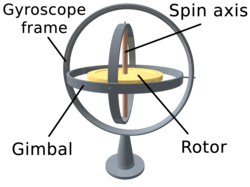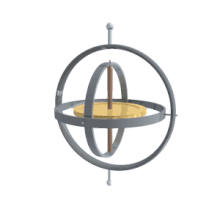

A gyroscope (from Ancient Greek γῦρος gŷros, "round" and σκοπέω skopéō, "to look") is a device used for measuring or maintaining orientation and angular velocity.[1][2] It is a spinning wheel or disc in which the axis of rotation (spin axis) is free to assume any orientation by itself. When rotating, the orientation of this axis is unaffected by tilting or rotation of the mounting, according to the conservation of angular momentum.
Gyroscopes based on other operating principles also exist, such as the microchip-packaged MEMS gyroscopes found in electronic devices (sometimes called gyrometers), solid-state ring lasers, fibre optic gyroscopes, and the extremely sensitive quantum gyroscope.[3]
Applications of gyroscopes include inertial navigation systems, such as in the Hubble Space Telescope, or inside the steel hull of a submerged submarine. Due to their precision, gyroscopes are also used in gyrotheodolites to maintain direction in tunnel mining.[4] Gyroscopes can be used to construct gyrocompasses, which complement or replace magnetic compasses (in ships, aircraft and spacecraft, vehicles in general), to assist in stability (bicycles, motorcycles, and ships) or be used as part of an inertial guidance system.
MEMS gyroscopes are popular in some consumer electronics, such as smartphones.
- ^ "Gyroscope". Oxford Dictionaries. Archived from the original on 5 May 2015. Retrieved 4 May 2015.
- ^ Kabai, Sándor (28 September 2007). "Gyroscope". Wolfram Demonstrations Project. Wolfram. Archived from the original on 30 April 2008.
- ^ Tao, W.; Liu, T.; Zheng, R.; Feng, H. (2012). "Gait Analysis Using Wearable Sensors". Sensors. 12 (2). Basel, Switzerland: 2255–2283. Bibcode:2012Senso..12.2255T. doi:10.3390/s120202255. PMC 3304165. PMID 22438763..
- ^ "20 things you didn't know about tunnels". Discover. 29 April 2009. Archived from the original on 15 June 2009.